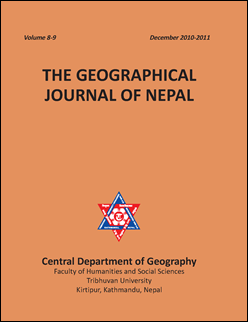Seismic Vulnerability Assessment of Buildings in GIS Environment: Dhankuta Municipality, Nepal
DOI:
https://doi.org/10.3126/gjn.v9i0.17466Keywords:
Seismic vulnerability, Earthquake hazard, Building characteristics, Factors of vulnerabilityAbstract
This study was carried out to assess the Seismic vulnerability of buildings in Dhankuta municipality. It includes estimating probable building damage at different intensities for certain earthquake scenario. This study has three-fold objectives. At first, nature and types of buildings were identified based on field survey and then probable buildings damage condition under different earthquake scenarios was assessed based on GIS built different hazard layers. Lastly, factors responsible for increasing risk of building vulnerability was identified based on existing studies. The building information of 4287 both residential and non residential buildings and 7849 separate floor were collected. Among them, 82.79 percent floors were used for residential purpose, 7.86 percent for commercial purpose and 9.35 percent for other purposes. Most of these buildings were constructed with stone in mud mix. Around 51.4 percent buildings were built 20 to 50 years ago. The building vulnerability in different earthquake scenario is assumed at different intensities. The assessment of vulnerability of building, building damage matrix, GIS and seismic intensity map were used. To estimate the buildings damage three earthquake scenario i.e. Udayapur, North-Sunsari and South-Sunsari earthquake scenarios were used. It is estimated that if Udayapur earthquake strike the municipality 14.21% of the total buildings will totally collapse the rest 83.33% will be partially damaged. The ward number 7, 6, 1, and 5 have buildings with high vulnerability due to old buildings, building attached and some parameters of construction materials. This study recommends that awareness programme about how to make buildings safe from earthquake be lunched by the responsible agencies such as municipality.
The Geographical Journal of Nepal, Vol. 8-9, 2010-2011: 1-12
Downloads
Downloads
Published
How to Cite
Issue
Section
License
© Authors




